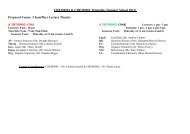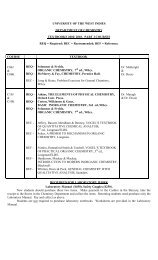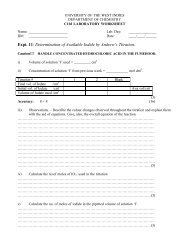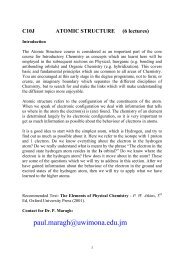faculty of pure and applied sciences - The Department of Chemistry ...
faculty of pure and applied sciences - The Department of Chemistry ...
faculty of pure and applied sciences - The Department of Chemistry ...
Create successful ePaper yourself
Turn your PDF publications into a flip-book with our unique Google optimized e-Paper software.
<strong>The</strong>se results indicate that cyanobacteria when used as bi<strong>of</strong>ertilizers in the wetl<strong>and</strong> cultivation <strong>of</strong> rice<strong>of</strong>fers the potential supplimenting its chemical nitrogen fertilizer requirements <strong>of</strong> up to 40kg N -1 ha.This is particularly sutitable for small farmers <strong>of</strong> rice as this technolgoy <strong>of</strong>fers the prospect <strong>of</strong>decreased input costs while facilitating increased quantity as well as quality <strong>of</strong> yields.O-20 DIVERSITY AMONG POPULATIONS OF XANTHOMONASCAMPESTRIS PV. VESICATORIA FROM FIVE EASTERNCARIBBEAN ISLANDS WITH RESPECT TO SECRETION OFEXTRACELLULAR ENZYMES, POLYSACCHARIDE PRODUCTIONAND PATHOGENICITYHenry A.M. 1 , Hamilton M.A.E. 1 , <strong>and</strong> O’ Garro L.W. 21 Biochemistry Section, <strong>Department</strong> <strong>of</strong> Basic Medical Sciences,Mona;2<strong>Department</strong> <strong>of</strong> Biology, Cave HillXanthomonas campestris pv.vesicatoria (proposed: Xanthomonas axonopodis pv. vesicatoria) isthe causative agent <strong>of</strong> bacterial spot disease <strong>of</strong> tomato (Lycopersicon esculentum Mill.) <strong>and</strong> pepper(Capsicum annum L.) plants. 851 strains from five Eastern Caribbean isl<strong>and</strong>s (Antigua, Barbados,Grenada, St.Kitts, <strong>and</strong> St. Lucia) were screened for the production <strong>of</strong> amylase, glucanase, pectinase<strong>and</strong> protease. All the isolates were negative for the excretion <strong>of</strong> the glucanases <strong>and</strong> pectinasesindicating that these enzymes were not important in the pathogenicity <strong>of</strong> these strains. 85% <strong>of</strong> thestrains produced amylases <strong>and</strong> 77% produced proteases. Overall, 69% <strong>of</strong> the strains showed bothamylolytic <strong>and</strong> proteolytic activity. <strong>The</strong> quality <strong>of</strong> xanthan produced by the isolates was determinedby the flow rate <strong>of</strong> the gum, as this is directly proportional to viscosity. Bacterial strains thatproduced high viscosity xanthan showed higher cfu/11.5cm 2leaf area <strong>and</strong> faster symptomsdevelopment over a 10 – 15 day period, than strains <strong>of</strong> low viscosity gum production. <strong>The</strong> resultssuggest a possible relationship between enzyme pr<strong>of</strong>ile <strong>and</strong> pathogenicity as all the strains producinghigh viscosity gum produced both amylases <strong>and</strong> proteases.O-21 PHYSIOLOGY AND BIOCHEMISTRY OF SALT STRESS ONTHE AXILLARY BUD CULTURES OF CASSAVAPotlrui, Sasikala D.P. <strong>and</strong> Devi Prasad, P.V.<strong>Department</strong> <strong>of</strong> Life Sciences, MonaTwo local varieties <strong>of</strong> Cassava named UWI-1 <strong>and</strong> UWI-2 were brought in to tissue culture throughnodal cuttings <strong>and</strong> apical meristem cultures. Axillary bud cultures <strong>of</strong> these were used to study thephysiology <strong>and</strong> biochemistry <strong>of</strong> salinity stress, as tissue culture techniques <strong>of</strong>fer unique advantage insuch studies. <strong>The</strong> cultures were grown on Murashige <strong>and</strong> Skoog medium supplemented with micronutrients<strong>and</strong> vitamins . Various concentrations <strong>of</strong> salt in the medium were obtained by using crudesea salt ranging from 0 to 1.0%. Crude sea salt was used as it would provide salinities close tonaturally occurring salinities in providing not only sodium chloride but other salts as well.41










